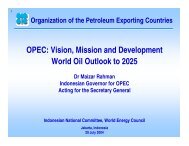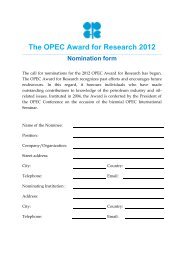Section One
Section One
Section One
You also want an ePaper? Increase the reach of your titles
YUMPU automatically turns print PDFs into web optimized ePapers that Google loves.
122<br />
Table 3.4<br />
Medium-term non-OPEC non-conventional oil supply outlook<br />
(excluding biofuels) in the Reference Case mb/d<br />
2010 2011 2012 2013 2014 2015<br />
US & Canada 1.7 1.9 2.0 2.3 2.6 2.8<br />
Western Europe 0.1 0.1 0.1 0.1 0.1 0.1<br />
OECD Pacific 0.0 0.0 0.1 0.1 0.1 0.1<br />
OECD 1.8 2.0 2.2 2.6 2.8 3.0<br />
Middle East & Africa 0.2 0.2 0.2 0.2 0.2 0.2<br />
Asia 0.0 0.0 0.0 0.0 0.0 0.1<br />
China 0.0 0.1 0.1 0.1 0.1 0.2<br />
Developing countries, excl. OPEC 0.2 0.2 0.3 0.3 0.4 0.4<br />
Non-OPEC 2.0 2.3 2.5 2.8 3.2 3.4<br />
Turning to the long-term, non-OPEC non-conventional oil (excluding biofuels)<br />
rises in the Reference Case by more than 6 mb/d over the period 2010–2035, to reach<br />
8.4 mb/d by 2035 (Table 3.5). This increase is mainly from shale oil and Canadian oil<br />
sands. The rate of increase is slightly higher than in last year’s WOO; partly a reflection<br />
of the higher oil prices assumed.<br />
Despite the large oil sands resource base, production is characterized by a relatively<br />
low level of peak production, which is balanced by a slow rate of decline.<br />
Therefore, oil sands have a much lower and much longer production plateau than<br />
conventional oil fields. This will limit the rate of production increases over the longterm.<br />
Moreover, oil sands require additional external energy, such as natural gas, for<br />
production. This has implications for CO 2 emissions associated with the production<br />
of this oil. Thus, any move to introduce carbon pricing in the future would have direct<br />
implications for supply economics. There are also other constraints, such as transportation<br />
infrastructure and water availability.<br />
Shale oil has also been associated with a number of negative impacts upon the<br />
environment. Carbon emissions, groundwater pollution and high levels of water<br />
usage are commonly cited problems. Nevertheless, estimates of shale oil resources<br />
remain uncertain, but seem to indicate large technically recoverable volumes. Moreover,<br />
shale oil is not only found in the US, but also in Australia, parts of Europe,<br />
China and Russia. The expanding interest in this fuel points to a potentially significant<br />
contribution to future oil supplies (Box 3.1).
















